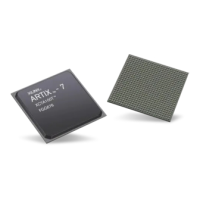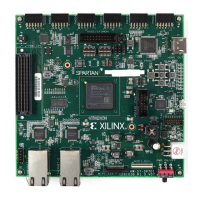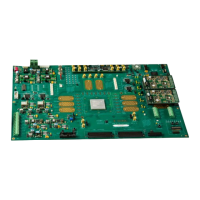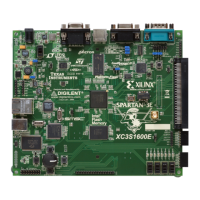190 www.xilinx.com 7 Series FPGAs GTP Transceivers User Guide
UG482 (v1.9) December 19, 2016
Chapter 4: Receiver
The content of the RX elastic buffer becomes invalid if an RX elastic buffer overflow or underflow
condition occurs. When any of these conditions occur, the RX elastic buffer should be reset and
reinitialized by using GTRXRESET, RXPCSRESET, RXBUFRESET, or the GTP transceiver
internally generated RX elastic buffer reset. The internally generated RX elastic buffer reset can
occur on channel bonding change, comma realignment, electrical idle, or rate change conditions.
The RX elastic buffer is also used for clock correction (see RX Clock Correction) and channel
bonding (see RX Channel Bonding, page 198). Clock correction is used in cases where XCLK and
RXUSRCLK are not frequency matched. Table 4-35 lists common clock configurations and shows
whether they require clock correction.
When the RX elastic buffer is used, the setting of CLK_COR_MIN_LAT affects the latency through
the buffer, regardless of whether clock correction is used.
RX Clock Correction
Functional Description
The RX elastic buffer is designed to bridge between two different clock domains, RXUSRCLK and
XCLK, which is the recovered clock from CDR. Even if RXUSRCLK and XCLK are running at
same clock frequency, there is always a small frequency difference. Because XCLK and
RXUSRCLK are not exactly the same, the difference can be accumulated to cause the RX elastic
buffer to eventually overflow or underflow unless it is corrected. To allow correction, each GTP
transceiver TX periodically transmits one or more special characters that the GTP transceiver RX is
allowed to remove or replicate in the RX elastic buffer as necessary. By removing characters when
the RX elastic buffer is too full and replicating characters when the RX elastic buffer is too empty,
the receiver can prevent overflow or underflow.
Table 4-35: Common Clock Configurations
Types of Clocking Require Clock Correction?
Synchronous system where both sides uses the reference clock
from the same physical oscillator.
No
Asynchronous system when separate reference clocks are used and
the GTP transceiver receiver uses an RX recovered clock.
No
Asynchronous system when separate reference clocks are used and
the GTP transceiver receiver uses a local clock.
Yes

